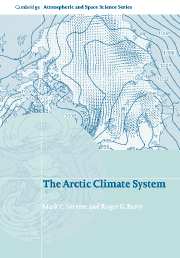Book contents
- Frontmatter
- Contents
- Preface page
- Acknowledgements
- List of Abbreviations
- 1 The evolution of knowledge about the Arctic and its climate
- 2 Physical characteristics and basic climatic features
- 3 The basic atmospheric heat budget
- 4 The atmospheric circulation
- 5 The surface energy budget
- 6 Precipitation, net precipitation and river discharge
- 7 Arctic ocean–sea ice–climate interactions
- 8 Climate regimes of the arctic
- 9 Modeling the arctic climate system
- 10 Arctic paleoclimates
- 11 Recent climate variability, trends and the future
- References
- List of selected websites
- Index
- Plate Section
3 - The basic atmospheric heat budget
Published online by Cambridge University Press: 10 August 2009
- Frontmatter
- Contents
- Preface page
- Acknowledgements
- List of Abbreviations
- 1 The evolution of knowledge about the Arctic and its climate
- 2 Physical characteristics and basic climatic features
- 3 The basic atmospheric heat budget
- 4 The atmospheric circulation
- 5 The surface energy budget
- 6 Precipitation, net precipitation and river discharge
- 7 Arctic ocean–sea ice–climate interactions
- 8 Climate regimes of the arctic
- 9 Modeling the arctic climate system
- 10 Arctic paleoclimates
- 11 Recent climate variability, trends and the future
- References
- List of selected websites
- Index
- Plate Section
Summary
Overview
The fundamental role of the Arctic in the global climate system is to serve as the Northern Hemisphere “heat sink”. On an annual basis, net receipts of solar radiation in the Arctic are smaller than in equatorial regions. The atmosphere and ocean work to balance this differential radiative heating through poleward energy transports, with the atmosphere playing the primary role. Because of stronger differential radiative heating in winter, the atmospheric transports are largest at this time. The poleward transports into the Arctic region itself are maximized around the prime meridian and the date line. This reflects the location of the primary storm tracks, and, in winter, strong surface heat fluxes from open water areas – features that were briefly introduced in Chapter 2.
A useful approach to understand the energetics of the Arctic heat sink is to consider the atmospheric heat budget for a simplified polar cap (the region from 70° to 90° N extending from the surface to the top of the atmosphere). The budget can be expressed in terms of four components: (1) the change in atmospheric storage of moist static energy; (2) the net radiation balance at the top of the atmosphere; (3) the net poleward transport of moist static energy by the atmospheric circulation; (4) the net surface heat flux. Moist static energy is the sum of internal energy (sensible heat content), latent heat energy and potential energy.
- Type
- Chapter
- Information
- The Arctic Climate System , pp. 55 - 73Publisher: Cambridge University PressPrint publication year: 2005



